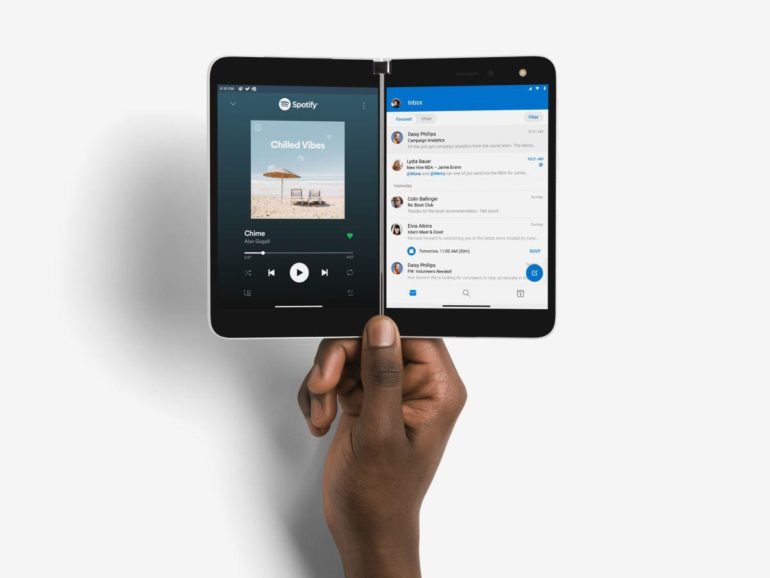After less than a year in the market, the successive price cuts are showing that the Surface Duo has been met with less enthusiasm from consumers than expected.
Image: Microsoft
“This is industry pushing technology, and it’s technology pushing possibilities,” said Microsoft’s chief product officer Panos Panay two years ago as he revealed the company’s first dual-screen device, the Surface Duo, to the public.
Microsoft went all-in and sold the Surface Duo as a premium product, with two side-by-side 5.6-inch displays that come together in a foldable device that stands right between a phone and a tablet. In September 2020, the device started shipping for an eyebrow-raising $1,400. But before long, catchy discounts were showing up, suggesting at least a slight excess of ambition on Microsoft’s part.
The Surface Duo was meant to help Microsoft make a serious dent in the mobile market after years of failure. “Microsoft was aiming to get back in the smartphone business,” Himank Joshi, researcher at analyst Forrester, tells ZDNet. “Launching the Surface Duo was part of the company’s strategy to ensure that it has a place in the future of mobile computing.”
The Redmond giant is not new to the world of mobile, but it is not best known for its successes.
Microsoft showcased its very own operating system for handsets, Windows Phone, as early as 2010, while Android was already taking off. A few years later, the company announced that it was acquiring Nokia’s phones business for a mighty €5.44 billion ($6.6 billion), in a bid to push Microsoft software on cutting-edge hardware.
Microsoft lost the bet. The purchase was completed in 2014; two years later, the company had to swallow a $7.6 billion writedown on the acquisition and cut around 20,000 jobs. Then Microsoft dropped support for Windows Phone altogether.
In the face of the growing Android-iOS duopoly, the company’s offer simply wasn’t appealing enough; and Windows Phone’s share of the market by 2017 was so small that it didn’t make sense for developers to rewrite their apps to run on Microsoft’s OS.
Yet Microsoft had little choice but to persevere. As demonstrated by Apple and Google, succeeding in the smartphone market is indeed the first step before locking loyal customers into an ecosystem of connected apps and services – an appealing prospect for a company like Microsoft that, from Outlook to Cortana, has plenty to offer when it comes to running software on mobile.
Faced with the failure of its Windows Phone, and a market virtually dominated by Google and Apple’s operating systems, Microsoft changed strategies for the Surface Duo. The Redmond giant decided to forget trying to make its own mobile operating system the star, and embrace Android instead in the hope of grabbing the attention of the wider world.
This means that the Duo comes with pre-installed Google apps, as well as the Play Store and Google Search bar.
“Partnering with Google and adopting Android was the right thing to do on the OS front as Microsoft has been failing with its Windows Phone operating systems for a long time,” says Joshi. “This provided Microsoft with a huge addressable Android user base and a rich ecosystem of apps and services which could have driven device adoption.”
It’s a strategy that has been in the works for some time now, and has seen Microsoft signing various deals that enable the company to push its ecosystem of apps and services on alternative operating systems.
When Samsung launched the Galaxy S6 and S6 Edge, for example, the South Korean giant announced that it had agreed to pre-install OneNote, OneDrive and Skype on the devices. Samsung also pre-installed Word, Excel, PowerPoint, OneNote, OneDrive and Skype on some of its Android tablets.
In another effort to strengthen its ecosystem despite the lack of a hand in the mobile market, Microsoft also released the Microsoft Your Phone app, which enables Windows 10 users to interact with their photos, messages and notifications on their Android devices directly from their PC screens.
“Microsoft, just like other players, is going after an ecosystem approach with its products and services. This means it will pursue all avenues that would help them strategically in this effort,” Maurice Klaehne, research analyst at Counterpoint Research, tells ZDNet.
Consumers clearly weren’t excited about having Windows on their smartphone. In that context, partnering with Android seemed the right call – and it could have worked had Microsoft not decided to base the company’s comeback in mobile on a brand-new form factor that is yet to win users’ hearts.
In a marketplace crowded with smartphones and tablets, Microsoft had to find a way to differentiate itself. The company pitched the Surface Duo as a complete rethink of productivity, driven by the ability to multitask. Using both screens, users can view their Outlook email and Calendar side-by-side, for example; or they can participate in a Teams meeting on the left, while watching their colleague’s presentation on the right.
What’s more: both screens are connected with a custom hinge that can rotate 360 degrees, which effectively means that the Duo falls under the category of foldable devices.
All of these specs come together to justify the unusually high price point that the Surface Duo was originally selling at. The problem? The device is innovative in principle, but in practice, it seems to have failed on a key aspect: understanding what consumers actually want.
“Duo is one of the examples of product development being done without learning user behavior,” Mikako Kitagawa, analyst at Gartner, tells ZDNet. “I don’t believe consumers are looking for all-in-one devices with smartphone and tablet combined.”
The device is too bulky as a smartphone and too clumsy as a tablet, continues Kitagawa, who is adamant that the series of price cuts since launch are a reflection of the Surface Duo’s unsuccessful performance so far.
SEE: 5G smartphones have arrived. But for many, the reason to upgrade is still missing
Especially at a $1,400 price tag, the Duo was widely found not to do much apart from providing a Microsoft-optimized Android phone. Worst still, some of the specs that are key to the appeal of a mobile device failed to convince: for example, the 11 MP camera, the older Snapdragon 855 processor and the relatively heavy weight of the device disappointed many users.
Microsoft told ZDNet that it believes there’s always room for new perspective rooted in solving unmet customer needs, and that Surface Duo makes a compelling case for this new “dual-screen” category, helping to solve challenges that three out of four customers report facing while attempting to compete complex tasks away from their PCs. It said, regarding recent promotions, “Microsoft offers competitive pricing on all its products, which includes offering discounts and promotions on an ongoing basis”.
For Neil Mawston, analyst at Strategy Analytics, the Surface Duo was a “flop”, and without much surprise. “Microsoft has struggled in smartphones for decades because its business-led culture does not resonate with the consumer,” Mawston tells ZDNet.
“Businesses want dull stability, while consumers desire excitement,” he continues. “Microsoft’s hardware, software and apps are too often clunky and fail to match the slick styling of Apple iPhone or the usability of Android.”
The mobile market has been consolidating between Apple, Samsung, Oppo, Vivo and Xiaomi. Each of these manufacturers has now amassed large customer bases, and it will be challenging for Microsoft to compete and thrive against such strong market shares.
For Mawston, Microsoft’s best move would be to focus on segments that have already shown that they can bring growth – namely, tablets like the Surface Book, Pro and Go devices. The company is already a leader in the market, and its outlook there seems much brighter, according to the analyst.
But there is another perspective on the Surface Duo story. Perhaps the dual-screen device was not all that big a deal to Microsoft after all, and instead was designed to be an experimental shot at a new form factor in mobile – a way to test the water with consumers, as part of a wider attempt to deliver Microsoft services on new devices.
For Ben Wood, chief analyst at CCS Insight, there was less at stake for Microsoft with the Surface Duo than it might seem. The ambition was to take device design into new directions, says Wood, and the Duo was a first try at understanding what might work best.
Rather than a failure, therefore, the device’s lack of success is more of a learning point that the company can use to design its next innovation. Indeed, there are suggestions that a Surface Duo 2 is on the horizon.
“I believe Microsoft will continue to experiment with devices like the Surface Duo,” Wood tells ZDNet. “It provides a chance to expand the reach of its increasingly successful Surface devices business and as technology evolves, and new components like flexible displays start to get integrated into devices, the lessons from the Surface Duo could be very valuable.”
The mobile market is entering a phase of growth, and after a year of cautious spending, consumers are now eager to replace their handsets. What’s more: the arrival of 5G-enabled devices is triggering a new wave of innovation that analysts are describing as a smartphone “supercycle”.
In other words, now is the right time to win consumers’ favors with innovative devices that offer exciting experiences. The question is whether Microsoft will continue to try to seize that opportunity.



